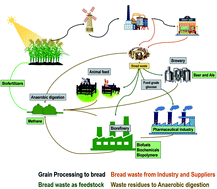Recycling bread waste into chemical building blocks using a circular biorefining approach
Abstract
Food waste is a global problem, causing significant environmental harm and resulting in substantial economic losses globally. Bread is the commonly wasted food item in the developed world and presents a severe problem for the majority of European nations. It is the second most wasted food item in the UK after potatoes, with an equivalent of 20 million slices of bread thrown away daily. Bread is a starchy material and a rich and clean source of easily extractable fermentable sugars – this is in direct contrast to lignocellulosic feedstocks where harsh physical, chemical and/or enzymatic pretreatment processes are required for release of fermentable sugars. Furthermore, these necessary lignocellulosic pretreatment methods often produce sugars contaminated with fermentation inhibitors. Therefore, bread waste presents a clear opportunity as a potential carbon source for novel commercial processes and, to this end, several alternative routes have been developed to utilize bread waste. Possibilities for direct recycling of bread waste within the food industry are limited due to the relatively short material lifetime, stringent process and hygiene requirements. Anaerobic digestion (AD) and incineration are commonly employed methods for the valorisation of bread waste, generating limited amounts of green energy but with little other environmental or economic benefits. Most food wastes and by-products in the UK including bakery waste are treated through AD processes that fail to harness the full potential of the these wastes. This short communication reviews the challenges of handling bread waste, with a focus on a specific UK scenario. The review will consider how bread waste is generated across the supply chain, current practices to deal with the waste and logistics challenges in waste collection. The presence of clean and high-quality fermentable sugars, proteins and other nutrients in bread make it an ideal substrate for generating chemicals, fuels, bioplastics, pharmaceuticals and other renewable products through microbial fermentations. We suggest potential applications for recycling bread waste into its chemical building blocks through a fermentative route where a circular biorefining approach could maximize resource recovery and environmental savings and eliminate waste to as close to zero as possible.

- This article is part of the themed collections: Recent Open Access Articles and Sustainable Energy and Fuels Recent Review Articles


 Please wait while we load your content...
Please wait while we load your content...